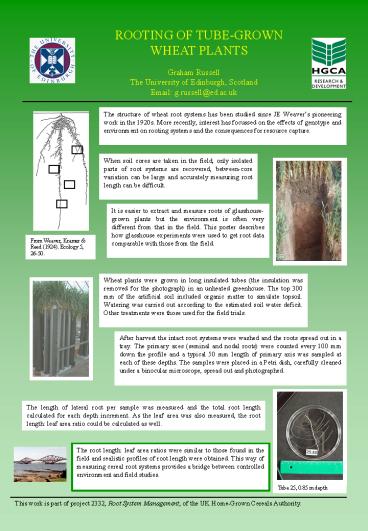ROOTING OF TUBE-GROWN WHEAT PLANTS
1 / 1
Title:
ROOTING OF TUBE-GROWN WHEAT PLANTS
Description:
ROOTING OF TUBE-GROWN WHEAT PLANTS. Graham Russell ... Wheat plants were grown in long insulated tubes (the insulation was removed for ... Tube 25, 0.85 m depth ... –
Number of Views:29
Avg rating:3.0/5.0
Title: ROOTING OF TUBE-GROWN WHEAT PLANTS
1
ROOTING OF TUBE-GROWN WHEAT PLANTS
Graham Russell The University of Edinburgh,
Scotland Email g.russell_at_ed.ac.uk
The structure of wheat root systems has been
studied since JE Weavers pioneering work in the
1920s. More recently, interest has focussed on
the effects of genotype and environment on
rooting systems and the consequences for resource
capture.
When soil cores are taken in the field, only
isolated parts of root systems are recovered,
between-core variation can be large and
accurately measuring root length can be
difficult.
It is easier to extract and measure roots of
glasshouse-grown plants but the environment is
often very different from that in the field. This
poster describes how glasshouse experiments were
used to get root data comparable with those from
the field.
From Weaver, Kramer Reed (1924). Ecology 5,
26-50.
Wheat plants were grown in long insulated tubes
(the insulation was removed for the photograph)
in an unheated greenhouse. The top 300 mm of the
artificial soil included organic matter to
simulate topsoil. Watering was carried out
according to the estimated soil water deficit.
Other treatments were those used for the field
trials.
After harvest the intact root systems were washed
and the roots spread out in a tray. The primary
axes (seminal and nodal roots) were counted every
100 mm down the profile and a typical 50 mm
length of primary axis was sampled at each of
these depths. The samples were placed in a Petri
dish, carefully cleaned under a binocular
microscope, spread out and photographed.
The length of lateral root per sample was
measured and the total root length calculated for
each depth increment. As the leaf area was also
measured, the root length leaf area ratio could
be calculated as well.
The root length leaf area ratios were similar to
those found in the field and realistic profiles
of root length were obtained. This way of
measuring cereal root systems provides a bridge
between controlled environment and field studies.
Tube 25, 0.85 m depth
This work is part of project 2332, Root System
Management, of the UK Home-Grown Cereals
Authority.































